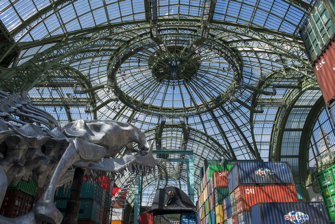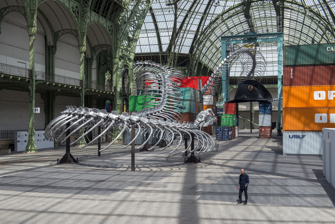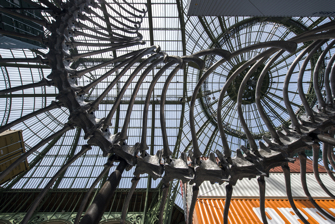Physically Brutal,
Metaphysically Rich

“Empires” by Huang Yong Ping. © Adagp, Paris 2016. Photo: Didier Plowy for RMN-GP
To misappropriate one of Donald Trump’s favorite words, this year’s Monumenta installation at the Grand Palais is “HUGE.” For the next few weeks, the space beneath the airy glass and filigree iron-ribbed roof of the exhibition hall is filled with a towering landscape composed of 309 shipping containers, a replica of a dockside gantry crane, a supersized version of Napoleon’s trademark bicorn hat, and a 254-meter-long, 130-ton aluminum snake skeleton.
The snake binds it all together, writhing in a series of loops over the boxes to end with its head, jaws gaping open, seemingly ready to

“Empires” by Huang Yong Ping. © Adagp, Paris 2016. Photo: Didier Plowy for RMN-GP
swallow both its own tail and the Napoleonic hat, which is perched at the epicenter of the show, arched across two columns of boxes.
Titled “Empires” by its creator, the Chinese-French artist Huang Yong Ping, the whole installation is designed as a complex of multiple, interlocking symbols. Physically, at first sight, it’s brutalism leavened with kitsch, though as you walk around, it offers some interesting perspectives. But metaphysically it’s intended to be rich. At one level, the containers stand for the overweening ambitions of global trade and capitalism – or maybe the refuges of its displaced victims; the hat, a blown-up replica of one worn by the Emperor at the bloody battle of Eylau, is offered as semiotic shorthand for the hubris of military conquest.
The hat “is the symbol of symbols, an absolute symbol of power,” Huang told Paris Update in an interview, but also a symbol of “emptiness, which is important in Chinese philosophy.”
The snake, meanwhile “is a symbol of mutation,” he said. “Curling through the containers, it brings movement to the work. The mouth is wide open, ready to swallow. It looks at the hat and its own tail. All the cycle of history is there.”
This is big, ambitious stuff, physically and philosophically. The problem is that what the artist puts in isn’t necessarily what the viewer gets out.
“When you are inside the Grand Palais, you will not have a global view of the installation,” conceded Axelle Blanc, the Monumenta project

“Empires” by Huang Yong Ping. © Adagp, Paris 2016. Photo: Didier Plowy for RMN-GP
coordinator, in a joint interview with Huang. “It’s an artwork that initially resists global comprehension.”
All other considerations aside, the size alone creates its own challenges. A lot of contemporary art relies on hype, and it’d be easy to write this off as a prime example. On the other hand, Huang’s history as a dedicated contrarian earns him the right to a closer look.
Born in 1954 in Xiamen, formerly China’s foreign port concession known as Amoy, he survived Mao’s Cultural Revolution to emerge as an avant-garde provocateur in 1986. In that year he founded Xiamen Dada, a postmodern group that challenged Communist realism with a mix of Zen Buddhism and Dadaist Surrealism. Describing his artistic practice as anti-art, anti-history and anti-self-expression, he attacked deterministic narratives by creating chance works formulated by the spin of a roulette wheel or the throw of divining sticks. In one early sculpture, he conflated Chinese and Western art histories by pulping a volume of each in a washing machine before mounting the resulting mash on a piece of broken glass over an empty tea chest.
By an irony of fate he was in Paris in 1989 for an exhibition celebrating the bicentenary of the French Revolution when the suppression of the Tiananmen protests drove him into exile.
None of this back-history is visible in the Grand Palais installation. But it’s there, impregnated in the work’s brutal, menacing, absurd, lightly whimsical entirety.
Is it worth seeing? Well, it’s probably the biggest Monumenta ever, and it may be the last, with the Grand Palais about to close for a multiyear restoration program.
Then again, you only have to look at 20th-century Fascist/Communist monolithic art to recognize that size isn’t everything. Ironic that such a contrarian should express himself on such a scale.
But yes, finally, worth seeing, and worth buying the excellently conceived catalog to get a grip on what’s behind what you’re looking at.
Galeries Nationales du Grand Palais: 3, avenue du Général Eisenhower, 75008 Paris. Métro: Champs-Elysées Clemenceau. Tel.: 01 44 13 17 17. Open Thursday-Saturday, 10am-10pm, Sunday-Monday and Wednesday, 10am-7pm. Closed Tuesday. Admission: €10. Through June 18, 2016. www.grandpalais.fr
Reader reaction: Click here to respond to this article (your response may be published on this page and is subject to editing).
More reviews of Paris art shows.
© 2016 Paris Update
Favorite